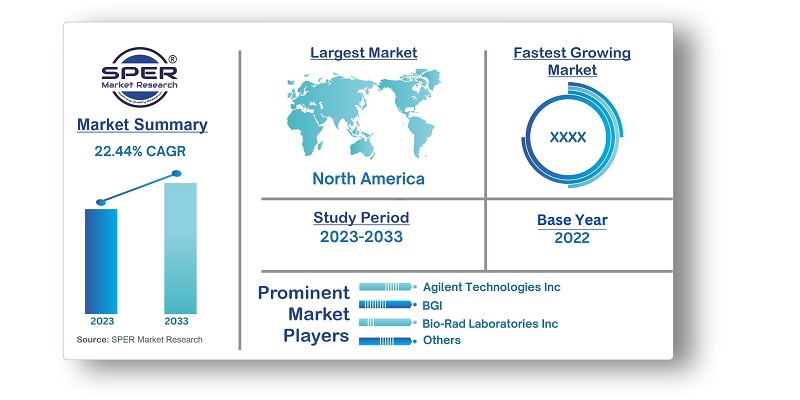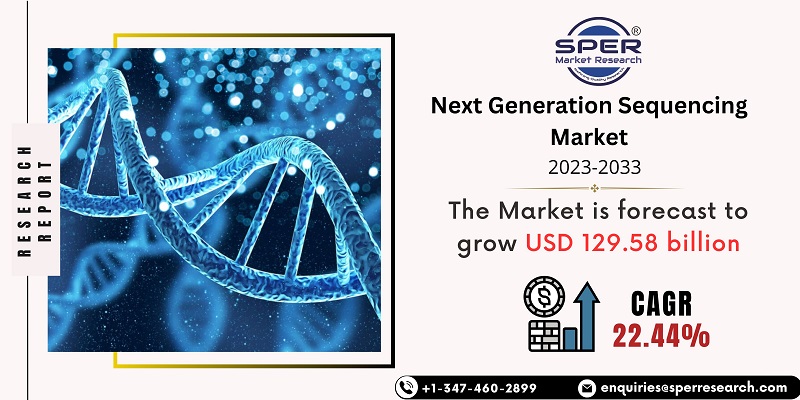
Next-generation Sequencing (NGS) Market Growth, Size, Trends, Demand, Revenue and Challenges
Global Next Generation Sequencing Market Size- By Product Type, By Type of Sequencing Technology, By Application, By End-User- Regional Outlook, Competitive Strategies and Segment Forecast to 2033
| Published: May-2022 | Report ID: BIOT2223 | Pages: 1 - 236 | Formats*: |
| Category : Biotechnology | |||
- Advancements in NGS Technology: Next-generation sequencing has witnessed significant technological advancements in recent years, leading to increased sequencing capacity, improved accuracy, and reduced costs. These advancements have made NGS more accessible and affordable for a wider range of applications, driving its adoption across various sectors.
- June 2023: Together with Geneyx - an AI platform, Oxford Nanopore Technologies Plc, a developer of nanopore sequencing technology, unveiled a scalable software solution for enhancing next-generation nanopore sequencing technology. This will provide hospitals and health centres with analytical data related to genome sequencing, including genetic labs.


| Report Metric | Details |
| Market size available for years | 2019-2033 |
| Base year considered | 2022 |
| Forecast period | 2023-2033 |
| Segments covered | By Product Type, By Type of Sequencing Technology, By Application, By End-User |
| Regions covered | Asia-Pacific, Europe, Middle East and Africa, North America, Latin America |
| Companies Covered | Agilent Technologies Inc., BGI, Bio-Rad Laboratories Inc., CD Genomics, DNASTAR Inc., Eurofins GATC Biotech GmbH, F. Hoffmann-La Roche AG, Genomatix GmbH, Illumina Inc., Intrexon Bioinformatics Germany GmbH (Precigen Inc.), Macrogen Inc., Oxford Nanopore Technologies, Pacific Biosciences of California Inc., PerkinElmer Inc., Pillar Biosciences Inc., PierianDx Inc., QIAGEN N.V., Thermo Fisher Scientific Inc., Others |
- Healthcare Providers
- Pharmaceutical and Biotechnology Companies
- Academic and Research Institutions
- Diagnostic Laboratories
- Bioinformatics Companies
- Government Agencies and Regulatory Bodies
- Investors and Venture Capitalists
- Patients and Patient Advocacy Groups
- Insurance Companies and Payers
- Genomic Data and Biobanking Organizations
| By Product Type: |
|
| By Type of Sequencing Technology: |
|
| By Application: |
|
| By End-User: |
|
- Global Next Generation Sequencing Market Size (FY’2023-FY’2033)
- Description of Global Next Generation Sequencing Market
- Segmentation of Global Next Generation Sequencing Market By Product Type (Reagents and Consumables, Software, Products & Services, Instruments)
- Segmentation of Global Next Generation Sequencing Market By Type of Sequencing Technology (CHIP Sequencing, De Novo Sequencing, Methyl Sequencing, RNA Sequencing, Targeted Resequencing, Whole Exome Sequencing, Whole Genome Sequencing)
- Segmentation of Global Next Generation Sequencing Market By Application (Agriculture and Animal Research, Diagnostics, Drug Discovery, Genetic Screening, Personalized Medicine, Other Applications)
- Segmentation of Global Next Generation Sequencing Market By End-User (Academics and Research Centres, Contract Research Organizations, Hospitals and Healthcare Institutions, Pharmaceutical and Biotechnology Companies, Others)
- Statistical Snap of Global Next Generation Sequencing Market
- Expansion Analysis of Global Next Generation Sequencing Market
- Problems and Obstacles in Global Next Generation Sequencing Market
- Competitive Landscape in the Global Next Generation Sequencing Market
- Impact of COVID-19 and Demonetization on Global Next Generation Sequencing Market
- Details on Current Investment in Global Next Generation Sequencing Market
- Competitive Analysis of Global Next Generation Sequencing Market
- Prominent Players in the Global Next Generation Sequencing Market
- SWOT Analysis of Global Next Generation Sequencing Market
- Global Next Generation Sequencing Market Future Outlook and Projections (FY’2023-FY’2033)
- Recommendations from Analyst
1.1. Scope of the report1.2. Market segment analysis
2.1. Research data source2.1.1. Secondary Data2.1.2. Primary Data2.1.3. SPER’s internal database2.1.4. Premium insight from KOL’s2.2. Market size estimation2.2.1. Top-down and Bottom-up approach2.3. Data triangulation
4.1. Driver, Restraint, Opportunity and Challenges analysis4.1.1. Drivers4.1.2. Restraints4.1.3. Opportunities4.1.4. Challenges4.2. COVID-19 Impacts of the Global Next Generation Sequencing Market
5.1. SWOT Analysis5.1.1. Strengths5.1.2. Weaknesses5.1.3. Opportunities5.1.4. Threats5.2. PESTEL Analysis5.2.1. Political Landscape5.2.2. Economic Landscape5.2.3. Social Landscape5.2.4. Technological Landscape5.2.5. Environmental Landscape5.2.6. Legal Landscape5.3. PORTER’s Five Forces5.3.1. Bargaining power of suppliers5.3.2. Bargaining power of buyers5.3.3. Threat of Substitute5.3.4. Threat of new entrant5.3.5. Competitive rivalry5.4. Heat Map Analysis
6.1. Global Next Generation Sequencing Market Manufacturing Base Distribution, Sales Area, Product Type6.2. Mergers & Acquisitions, Partnerships, Product Launch, and Collaboration in Global Next Generation Sequencing Market
7.1. Global Next Generation Sequencing Market Value Share and Forecast, By Product Type, 2023-20337.2. Instruments7.3. Reagents and Consumables7.4. Products & Services7.5. Software
8.1. Global Next Generation Sequencing Market Value Share and Forecast, By Type of Sequencing Technology, 2023-20338.2. CHIP Sequencing8.3. De Novo Sequencing8.4. Methyl Sequencing8.5. RNA Sequencing8.6. Targeted Resequencing8.7. Whole Exome Sequencing8.8. Whole Genome Sequencing
9.1. Global Next Generation Sequencing Market Value Share and Forecast, By Application, 2023-20339.2. Agriculture and Animal Research9.3. Diagnostics9.4. Drug Discovery9.5. Genetic Screening9.6. Personalized Medicine9.7. Other Applications
10.1. Global Next Generation Sequencing Market Value Share and Forecast, By End-User, 2023-203310.2. Academics and Research Centres10.3. Contract Research Organizations10.4. Hospitals and Healthcare Institutions10.5. Pharmaceutical and Biotechnology Companies10.6. Others
11.1. Global Next Generation Sequencing Market Size and Market Share
12.1. Global Next Generation Sequencing Market Size and Market Share By Product Type (2019-2026)12.2. Global Next Generation Sequencing Market Size and Market Share By Product Type (2027-2033)
13.1. Global Next Generation Sequencing Market Size and Market Share By Type of Sequencing Technology (2019-2026)13.2. Global Next Generation Sequencing Market Size and Market Share By Type of Sequencing Technology (2027-2033)
14.1. Global Next Generation Sequencing Market Size and Market Share By Application (2019-2026)14.2. Global Next Generation Sequencing Market Size and Market Share By Application (2027-2033)
15.1. Global Next Generation Sequencing Market Size and Market Share By End-User (2019-2026)15.2. Global Next Generation Sequencing Market Size and Market Share By End-User (2027-2033)
16.1. Global Next Generation Sequencing Market Size and Market Share By Region (2019-2026)16.2. Global Next Generation Sequencing Market Size and Market Share By Region (2027-2033)16.3. Asia-Pacific16.3.1. Australia16.3.2. China16.3.3. India16.3.4. Japan16.3.5. South Korea16.3.6. Rest of Asia-Pacific16.4. Europe16.4.1. France16.4.2. Germany16.4.3. Italy16.4.4. Spain16.4.5. United Kingdom16.4.6. Rest of Europe16.5. Middle East and Africa16.5.1. Kingdom of Saudi Arabia16.5.2. United Arab Emirates16.5.3. Rest of Middle East & Africa16.6. North America16.6.1. Canada16.6.2. Mexico16.6.3. United States16.7. Latin America16.7.1. Argentina16.7.2. Brazil16.7.3. Rest of Latin America
17.1. Agilent Technologies Inc.17.1.1. Company details17.1.2. Financial outlook17.1.3. Product summary17.1.4. Recent developments17.2. BGI17.2.1. Company details17.2.2. Financial outlook17.2.3. Product summary17.2.4. Recent developments17.3. Bio-Rad Laboratories Inc.17.3.1. Company details17.3.2. Financial outlook17.3.3. Product summary17.3.4. Recent developments17.4. CD Genomics17.4.1. Company details17.4.2. Financial outlook17.4.3. Product summary17.4.4. Recent developments17.5. DNASTAR Inc.17.5.1. Company details17.5.2. Financial outlook17.5.3. Product summary17.5.4. Recent developments17.6. Eurofins GATC Biotech GmbH17.6.1. Company details17.6.2. Financial outlook17.6.3. Product summary17.6.4. Recent developments17.7. F. Hoffmann-La Roche AG17.7.1. Company details17.7.2. Financial outlook17.7.3. Product summary17.7.4. Recent developments17.8. Genomatix GmbH17.8.1. Company details17.8.2. Financial outlook17.8.3. Product summary17.8.4. Recent developments17.9. Illumina Inc.17.9.1. Company details17.9.2. Financial outlook17.9.3. Product summary17.9.4. Recent developments17.10. Intrexon Bioinformatics Germany GmbH (Precigen Inc.)17.10.1. Company details17.10.2. Financial outlook17.10.3. Product summary17.10.4. Recent developments17.11. Macrogen Inc.17.11.1. Company details17.11.2. Financial outlook17.11.3. Product summary17.11.4. Recent developments17.12. Oxford Nanopore Technologies17.12.1. Company details17.12.2. Financial outlook17.12.3. Product summary17.12.4. Recent developments17.13. Pacific Biosciences of California Inc.17.13.1. Company details17.13.2. Financial outlook17.13.3. Product summary17.13.4. Recent developments17.14. PerkinElmer Inc.17.14.1. Company details17.14.2. Financial outlook17.14.3. Product summary17.14.4. Recent developments17.15. Pillar Biosciences Inc.17.15.1. Company details17.15.2. Financial outlook17.15.3. Product summary17.15.4. Recent developments17.16. PierianDx Inc.17.16.1. Company details17.16.2. Financial outlook17.16.3. Product summary17.16.4. Recent developments17.17. QIAGEN N.V.17.17.1. Company details17.17.2. Financial outlook17.17.3. Product summary17.17.4. Recent developments17.18. Thermo Fisher Scientific Inc.17.18.1. Company details17.18.2. Financial outlook17.18.3. Product summary17.18.4. Recent developments17.19. Others
SPER Market Research’s methodology uses great emphasis on primary research to ensure that the market intelligence insights are up to date, reliable and accurate. Primary interviews are done with players involved in each phase of a supply chain to analyze the market forecasting. The secondary research method is used to help you fully understand how the future markets and the spending patterns look likes.
The report is based on in-depth qualitative and quantitative analysis of the Product Market. The quantitative analysis involves the application of various projection and sampling techniques. The qualitative analysis involves primary interviews, surveys, and vendor briefings. The data gathered as a result of these processes are validated through experts opinion. Our research methodology entails an ideal mixture of primary and secondary initiatives.



Frequently Asked Questions About This Report
PLACE AN ORDER
Year End Discount
Sample Report
Pre-Purchase Inquiry
NEED CUSTOMIZATION?
Request CustomizationCALL OR EMAIL US
100% Secure Payment






Related Reports
Our Global Clients
Our data-driven insights have influenced the strategy of 200+ reputed companies across the globe.






















